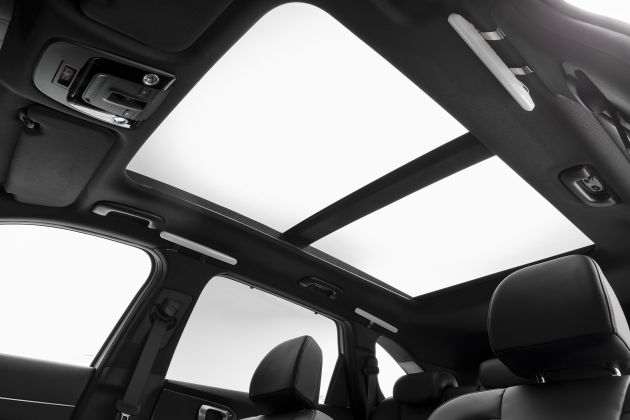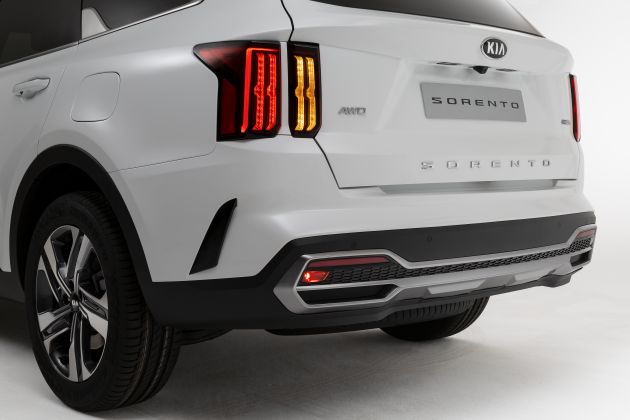With the Geneva Motor Show cancelled, Kia took its time to reveal full details of the Sorento – originally scheduled on March 3, the floodgate were finally opened today. Now, we’ve got nearly everything we know about the fourth-generation SUV, so let’s get straight into it.
The new Sorento sits on Kia’s latest N3 midsize crossover platform and uses a blend of steel and aluminium in its construction, plus a greater percentage of Advanced High-Strength Steel and hot-stamped steel compared to its predecessor. Despite torsional rigidity being 12.5% higher than the “perceived safety leader” in the segment, the bodyshell is 54 kg (5.6%) lighter than before.
It’s also slightly larger than before, the car growing 10 mm in each direction to 4,810 mm long, 1,900 mm wide and 1,695 mm tall. The wheelbase, however, has been lengthened some 35 mm to 2,815 mm; of this, 30 mm goes into the more rearward placement of the A-pillars. Together the shorter overhangs, this is said to provide the car with a more premium look.
As you can see, the new Sorento sports a much bolder design language compared to the handsome if rather conventional outgoing model. It’s more angular and features a greater use of sharp lines and faceted surfaces, most prominently at the rear.
Up front, you have the familiar “tiger nose” grille with U-shaped inserts, flowing neatly into the slim headlights with triple LED projectors – an effect made more pronounced by a continuous full-width chrome strip and L-shaped “tiger eye” daytime running lights. This entire graphic is set within a concave surface, under which sits a large central air intake and L-shaped bumper corners.
Along the side, you can see an arching shoulder line that wraps around the front and rear ends, and below this is a chrome fillet on the front fenders and doors, sort of mimicking a fender vent. Above the line, there’s an unusual chrome “shark fin” aft of the rear doors, while the door mirrors have been separated from the A-pillars for a cleaner, more premium look.
The rear end is by far the most radical part of the car, with prominent creases on the tailgate surrounding the number plate area. The four vertical tail light bars are rather reminiscent of a Ford Mustang, and the entire look is finished off with a large black bumper insert and multiple fake vents.
Inside, it’s an even bigger departure, with a horizontal dashboard that borrows more than a few cues from Mercedes-Benz. The most prominent of these is the large display panel, which houses a central touchscreen measuring up to 10.25 inches across, as well as an available 12.3-inch digital instrument display. Alongside these displays are haptic controls, which also feature on the climate controls.
European models come with UVO Connect telematics with Kia Live services such as live traffic information, weather forecasts, points of interest and on- and off-street parking information; users can also send their directions to their cars before setting off. The infotainment system enables Bluetooth pairing with up to two phones simultaneously, enabling different phones to be used for calls and music streaming.
The Sorento is also offered with wireless smartphone charging as well as a 12-speaker Bose surround sound system. Elsewhere, there are also eight vertical air vents, a tall centre console, a very Jaguar-esque rotary gear selector and a 64-colour ambient lighting system – again, just like a Mercedes. Kia boasts enhanced material quality in the interior, with metallic trim, embossed satin-effect surfaces and available Nappa leather.
The company also says that the Sorento’s larger dimensions and improved packaging provide more space for people and cargo, with greater legroom for first- and second-row passengers and more headroom for those in the third row. In addition to five- and seven-seater configurations, the Sorento will also be available for the first time in six-seater form with two individual second-row pews.
Luggage room has also increased by 32% with the rearmost pews up, to 187 litres. The platform accommodates electrification for the first time, so the new hybrid model has its battery located under the front passenger seat, rather than under the boot floor – resulting in a minimally-impacted boot space of 179 litres. With the third-row seats folded, cargo capacity increases to 821 litres (910 litres for five-seat models).
Safety-wise, the Sorento will be available with a full range of driver assistance systems, such as autonomous emergency braking with pedestrian, cyclist and oncoming traffic detection, blind spot monitoring with collision avoidance and rear cross traffic braking, traffic sign recognition, navigation-based adaptive cruise control with stop and go, lane centring assist, driver attention warning and Highway Driving Assist (HDA).
The Sorento will also be the first Kia in Europe to come with the Remote Smart Parking Assist (RSPA), enabling the car to be driven in and out of a parking spot using the key fob, autonomously braking if it detects another car, cyclist or pedestrian. Other available features include a door opening warning, autonomous braking for reverse parking and up to eight airbags, including a new centre airbag between the front seats.
Also offered is the remote Surround View Monitor which, as the name suggests, allows users to monitor their car’s surroundings via a smartphone, just like a BMW. A new multi-collision brake system also automatically applies the brakes after the airbags have been deployed, reducing the severity of secondary collisions.
European and Korean markets will be offered a choice of two Smartstream engines. The first is a 2.2 litre four-cylinder turbodiesel, now with an aluminium block that saves 19.5 kg over the outgoing cast iron block. It makes 202 PS at 3,800 rpm and 440 Nm from 1,750 to 2,750 rpm, routed through a new eight-speed wet dual-clutch transmission said to be two to three percent more efficient than a conventional automatic.
The other option is the aforementioned hybrid model that will also be offered in the United States, utilising a 1.6 litre turbocharged T-GDi petrol mill; on its own, it produces 180 PS at 5,500 rpm and 265 Nm from 1,500 to 4,500 rpm. Sandwiched between it and a six-speed automatic is an electric motor making another 60 PS and 265 Nm, resulting in a total output of 230 PS and 350 Nm. It is juiced by a 1.49 kWh lithium-ion battery.
Koreans and Americans are also getting a 2.5 litre turbo petrol engine with direct and indirect fuel injection; it makes 281 PS and 421 Nm and is paired to the eight-speed DCT. A plug-in hybrid variant will also be revealed towards the end of the year.
Having ridden on a monocoque platform since the second generation, the Sorento is claimed to provide a more comfortable ride and a more satisfying and enjoyable driving experience, thanks to the heavily revised fully-independent suspension.
A series of geometry changes and new components, as well as tweaks to the suspension structure, have minimised the effects of surface imperfections, reduced noise and vibration and improved body control and steering responsiveness in the corners. The longer wheelbase has helped smoothen the ride, while the stiffer bodyshell – utilising a four percent average increase in high-tensile steel – cuts down on NVH.
Models with the optional all-wheel drive system also get a new Terrain Mode with mud, snow and sand settings. The system adjusts stability control intervention, the torque distribution between all four wheels and the transmission shift times to help the Sorento find and maintain traction on slippery surfaces.
Source: Read Full Article









